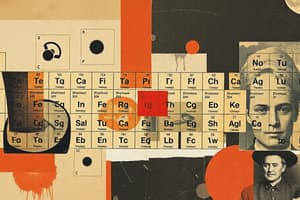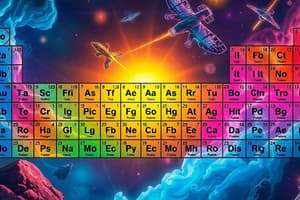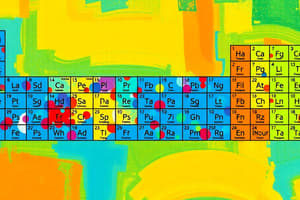Podcast
Questions and Answers
¿Cuál de las siguientes opciones no representa una fuente confiable de información?
¿Cuál de las siguientes opciones no representa una fuente confiable de información?
- Una publicación revisada por expertos.
- Un blog personal sin referencias. (correct)
- Un artículo de un periódico de prestigio.
- Una página de Wikipedia sobre el tema.
¿Qué aspecto no es clave al evaluar la validez de una información?
¿Qué aspecto no es clave al evaluar la validez de una información?
- Las fuentes citadas en el documento.
- El autor de la información.
- La fecha en que se publicó.
- La longitud del texto. (correct)
¿Cuál de las siguientes afirmaciones sobre la información en línea es incorrecta?
¿Cuál de las siguientes afirmaciones sobre la información en línea es incorrecta?
- Cualquier información que se encuentre en línea es de calidad. (correct)
- No toda la información en línea es precisa.
- Los sitios web académicos generalmente son más confiables.
- Las redes sociales pueden propagar información falsa.
¿Qué método es ineficaz para comprobar la exactitud de una fuente?
¿Qué método es ineficaz para comprobar la exactitud de una fuente?
Al citar fuentes, es fundamental evitar:
Al citar fuentes, es fundamental evitar:
Flashcards
Hoja de cálculo
Hoja de cálculo
Un archivo que contiene una colección de datos organizados en filas y columnas.
Software de hoja de cálculo
Software de hoja de cálculo
Un programa de software que se utiliza para crear, editar y trabajar con hojas de cálculo.
Rango de celdas
Rango de celdas
Un conjunto de celdas que se seleccionan juntas dentro de una hoja de cálculo. Pueden ser adyacentes o no.
Fórmula
Fórmula
Signup and view all the flashcards
Celda
Celda
Signup and view all the flashcards
Study Notes
General Information
- The periodic table is a system for organizing elements
- It's arranged by increasing atomic number
- Similar properties are grouped together
- Elements with similar properties are in the same column (group)
- Elements with similar properties appear at regular intervals (periods)
Dobereiner's Triads
- Scientists tried to classify elements based on properties
- Dobereiner grouped elements into triads
- The atomic mass of the middle element was approximately the average of the other two elements in a triad
Newland's Law of Octaves
- Newland arranged elements in increasing atomic mass
- Properties repeated every eighth element, similar to musical octaves
- This system was not widely accepted
Mendeleev's Periodic Table
- Dmitri Mendeleev arranged elements by increasing atomic mass
- Similar properties grouped together in columns (groups)
- Left gaps for undiscovered elements
- Predicted properties of undiscovered elements correctly
- Mendeleev's periodic law states that physical and chemical properties of elements are a periodic function of their atomic masses
Modern Periodic Law
- The modern periodic law states that physical and chemical properties of elements are a periodic function of their atomic numbers
- This replaced Mendeleev's law
- Atomic number is a more accurate basis for organization than atomic mass
Periodic Table Organization
- Groups/families: Vertical columns
- Periods: Horizontal rows
- Representative elements (main group elements): Groups 1, 2, 13-18
- Transition elements: Groups 3-12
- Inner transition elements: Lanthanides (57-71) and Actinides (89-103)
- Metals: Generally on the left side of the periodic table
- Nonmetals: Generally on the right side of the periodic table
- Metalloids: Have properties intermediate between metals and nonmetals
Trends in the Periodic Table
- Atomic size: Generally increases down a group and decreases across a period
- Metallic character: Decreases across a period, and increases down a group
- Electronegativity: Increases across a period and decreases down a group
- Ionization energy: Increases across a period, and decreases down a group
- Reactivity: Varies across a period and down a group.
Groups
- Alkali metals (Group 1): Very reactive metals
- Alkaline earth metals (Group 2): Reactive metals
- Halogens (Group 17): Reactive nonmetals
- Noble gases (Group 18): Nonreactive, stable elements
Modern Periodic Table Improvements
- Use of atomic number instead of atomic mass
- More accurate organization of elements due to atomic number
- Accurate prediction of properties of undiscovered elements
- Better understanding of periodicity
Isotopes
- Atoms of the same element with different numbers of neutrons, but the same number of protons.
- Isotopes have the same chemical properties.
Studying That Suits You
Use AI to generate personalized quizzes and flashcards to suit your learning preferences.




